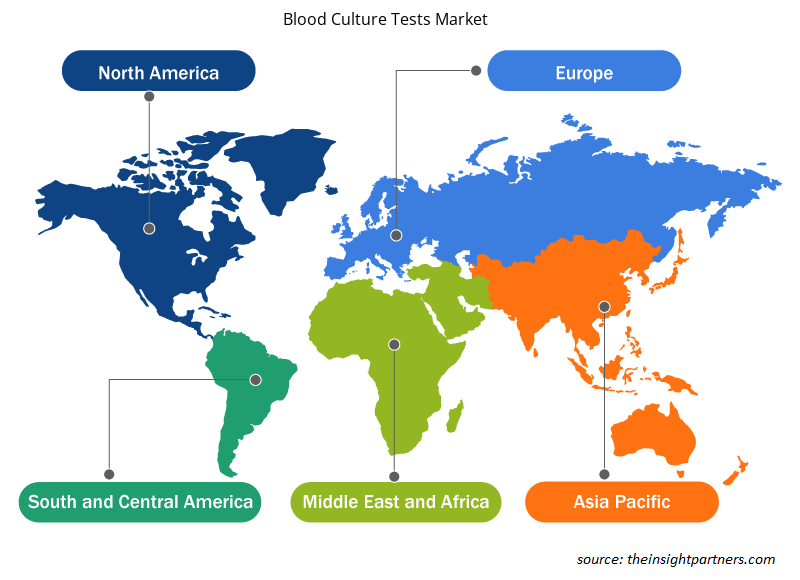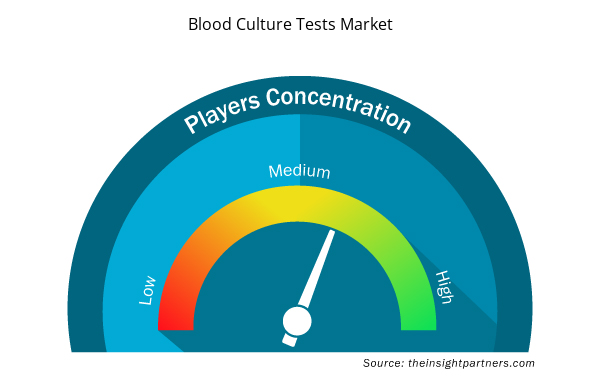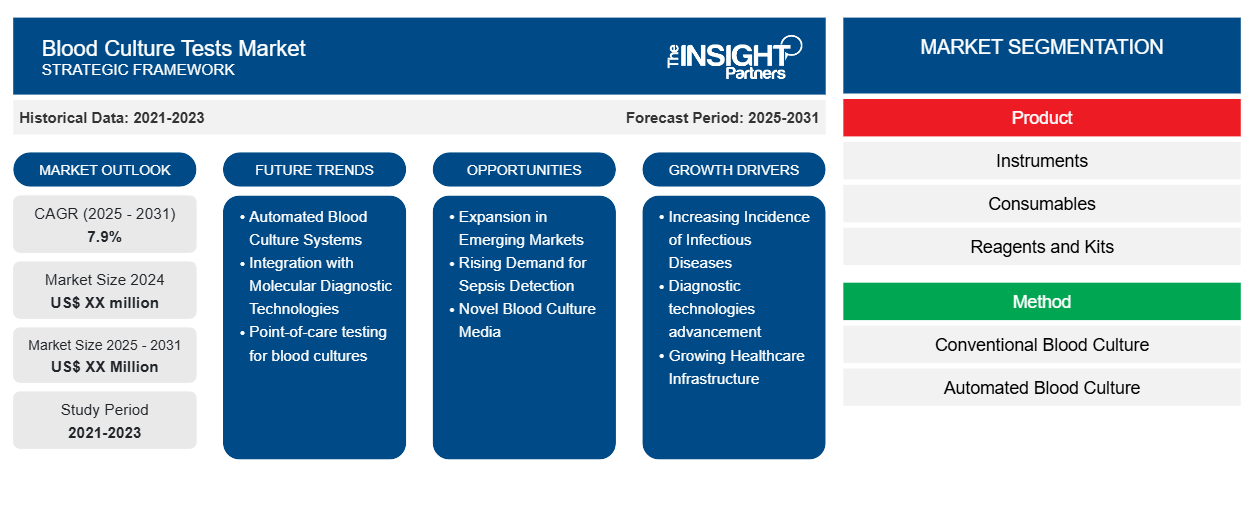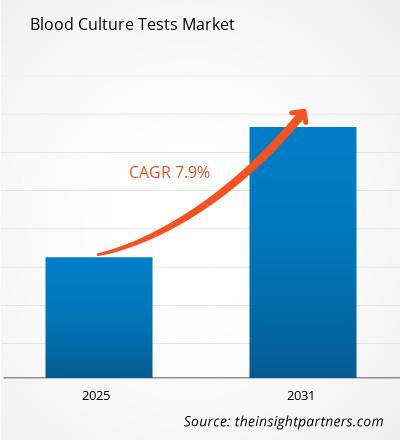Si prevede che il mercato dei test delle emocolture registrerà un CAGR del 7,9% dal 2023 al 2031, con una dimensione di mercato in espansione da XX milioni di dollari nel 2023 a XX milioni di dollari entro il 2031.
Il rapporto di mercato Blood Culture Tests copre l'analisi per prodotto (strumenti, materiali di consumo, reagenti e kit, software e servizi); metodo (emocoltura convenzionale, emocoltura automatizzata); tecnologia (tecnologia proteomica, tecnologia basata sulla coltura, tecnologia molecolare); utente finale (ospedali e cliniche, laboratori diagnostici e di ricerca, altri). L'analisi globale è ulteriormente suddivisa a livello regionale e nei principali paesi. Il rapporto offre il valore in USD per l'analisi e i segmenti di cui sopra.
Scopo del rapporto
Il report Blood Culture Tests Market di The Insight Partners mira a descrivere il panorama attuale e la crescita futura, i principali fattori trainanti, le sfide e le opportunità. Ciò fornirà spunti a vari stakeholder aziendali, come:
- Fornitori/produttori di tecnologia: per comprendere le dinamiche di mercato in evoluzione e conoscere le potenziali opportunità di crescita, consentendo loro di prendere decisioni strategiche informate.
- Investitori: condurre un'analisi completa delle tendenze in merito al tasso di crescita del mercato, alle proiezioni finanziarie del mercato e alle opportunità esistenti lungo la catena del valore.
- Enti di regolamentazione: regolamentano le politiche e le attività di controllo sul mercato allo scopo di ridurre al minimo gli abusi, preservare la fiducia degli investitori e sostenere l'integrità e la stabilità del mercato.
Segmentazione del mercato dei test di emocoltura
Prodotto
- Strumenti
- Materiali di consumo
- Reagenti e kit
- Software e servizi
Metodo
- Coltura del sangue convenzionale
- Coltura del sangue automatizzata
Tecnologia
- Tecnologia proteomica
- Tecnologia basata sulla cultura
- Tecnologia molecolare
Utente finale
- Ospedali e cliniche
- Laboratori di Diagnostica e Ricerca
- Altri
Utente finale
- Ospedali e cliniche
- Laboratori di Diagnostica e Ricerca
- Altri
Personalizza questo report in base alle tue esigenze
Riceverai la personalizzazione gratuita di qualsiasi report, comprese parti di questo report, o analisi a livello nazionale, pacchetto dati Excel, oltre a usufruire di grandi offerte e sconti per start-up e università
- Scopri le principali tendenze di mercato in questo rapporto.Questo campione GRATUITO includerà analisi di dati che spaziano dalle tendenze di mercato alle stime e alle previsioni.
Fattori trainanti della crescita del mercato dei test per emocoltura
- Aumento dell'incidenza delle malattie infettive: la crescente incidenza delle malattie infettive è il fattore più importante che spinge il mercato dei test delle emocolture. Ciò è dovuto alla crescente incidenza di infezioni, tra cui malattie batteriche, fungine e parassitarie. I test delle emocolture sono essenziali per diagnosticare sepsi, batteriemia e altre infezioni del flusso sanguigno, il che aumenta ulteriormente la domanda di questi strumenti diagnostici.
- Avanzamento delle tecnologie diagnostiche: le tecnologie di emocoltura, che sono state migliorate tramite automazione, monitoraggio in tempo reale e metodi di rilevamento più rapidi, stanno guidando la crescita del mercato. Tali progressi nei test di emocoltura migliorano la sensibilità, la velocità e l'accuratezza dei test, fornendo così diagnosi tempestive e risultati migliori.
- Crescente infrastruttura sanitaria: un gran numero di persone sta diventando più attento alla salute, stimolando così la domanda di test diagnostici, come i sistemi di emocoltura. Il miglioramento dell'infrastruttura sanitaria, specialmente nelle regioni in via di sviluppo, è anche responsabile dell'aumento dell'adozione di test di emocoltura per la diagnosi precoce e il trattamento delle infezioni.
Tendenze future del mercato dei test di coltura del sangue
- Sistemi automatizzati per emocoltura: c'è una grande tendenza verso sistemi automatizzati per emocoltura che portano a una maggiore produttività, minori costi di manodopera e una maggiore accuratezza. L'automazione nei processi di emocoltura aumenta l'efficienza operativa negli ospedali e nei laboratori riducendo il tempo per la diagnosi e migliorando il processo decisionale clinico.
- Integrazione con tecnologie di diagnostica molecolare: c'è una tendenza crescente nell'integrazione dei sistemi di emocoltura con strumenti di diagnostica molecolare. Questa integrazione aiuta nell'identificazione accurata e tempestiva dei patogeni che causano infezioni. Tecniche come la spettrometria di massa PCR e MALDI-TOF vengono incorporate per rilevare un'ampia gamma di patogeni dalle emocolture, migliorando ulteriormente l'efficienza diagnostica.
- Test point-of-care per emocolture: il test point-of-care per emocolture sta diventando sempre più popolare in terapia intensiva, pronto soccorso e contesti rurali. Consente il rapido rilevamento delle infezioni al letto del paziente con risultati più rapidi e una minore dipendenza dalle strutture di laboratorio centrali.
Opportunità di mercato per i test di emocoltura
- Espansione nei mercati emergenti: la crescente adozione di strumenti diagnostici avanzati nei mercati emergenti, in particolare in Asia-Pacifico, America Latina e Africa, rappresenta una grande opportunità per i test delle emocolture. Queste regioni affrontano la crescente diffusione di malattie infettive, nonché maggiori investimenti nell'assistenza sanitaria, richiedendo soluzioni per i test delle emocolture.
- Domanda crescente di rilevamento della sepsi: la principale causa di mortalità nei pazienti gravemente malati è la sepsi e la diagnosi precoce tramite test di emocoltura è essenziale per migliorare i tassi di sopravvivenza. La crescente attenzione alla diagnosi e alla gestione della sepsi offre opportunità per sviluppare test di emocoltura rapidi e avanzati in grado di rilevare la sepsi nelle sue fasi iniziali.
- Nuovi terreni di coltura del sangue: sviluppo di nuovi e innovativi terreni di coltura per le emocolture, aumentando così la sensibilità e la gamma del patogeno. Questi metodi innovativi ridurranno i risultati falsi negativi e consentiranno risultati diagnostici più affidabili ed estesi per quanto riguarda un'ampia gamma di infezioni.
Approfondimenti regionali sul mercato dei test di coltura del sangue
Le tendenze regionali e i fattori che influenzano il mercato dei test di coltura ematica durante il periodo di previsione sono stati ampiamente spiegati dagli analisti di Insight Partners. Questa sezione discute anche i segmenti e la geografia del mercato dei test di coltura ematica in Nord America, Europa, Asia Pacifico, Medio Oriente e Africa e Sud e Centro America.

- Ottieni i dati specifici regionali per il mercato dei test di coltura del sangue
Ambito del rapporto di mercato sui test di coltura del sangue
| Attributo del report | Dettagli |
|---|---|
| Dimensioni del mercato nel 2023 | XX milioni di dollari USA |
| Dimensioni del mercato entro il 2031 | XX milioni di dollari USA |
| CAGR globale (2023-2031) | 7,9% |
| Dati storici | 2021-2022 |
| Periodo di previsione | 2024-2031 |
| Segmenti coperti | Per Prodotto
|
| Regioni e Paesi coperti | America del Nord
|
| Leader di mercato e profili aziendali chiave |
|
Densità degli attori del mercato dei test di emocoltura: comprendere il suo impatto sulle dinamiche aziendali
Il mercato dei test di emocoltura sta crescendo rapidamente, spinto dalla crescente domanda degli utenti finali dovuta a fattori quali l'evoluzione delle preferenze dei consumatori, i progressi tecnologici e una maggiore consapevolezza dei benefici del prodotto. Con l'aumento della domanda, le aziende stanno ampliando le loro offerte, innovando per soddisfare le esigenze dei consumatori e capitalizzando sulle tendenze emergenti, il che alimenta ulteriormente la crescita del mercato.
La densità degli operatori di mercato si riferisce alla distribuzione di aziende o società che operano in un particolare mercato o settore. Indica quanti concorrenti (operatori di mercato) sono presenti in un dato spazio di mercato in relazione alle sue dimensioni o al valore di mercato totale.
Le principali aziende che operano nel mercato dei test delle emocolture sono:
- BD
- Thermo Fisher Scientific, Inc.
- bioMérieux SA
- Società Danaher
- F. Hoffmann-La Roche Ltd
Disclaimer : le aziende elencate sopra non sono classificate secondo un ordine particolare.

- Ottieni la panoramica dei principali attori del mercato dei test per le emocolture
Punti chiave di vendita
- Copertura completa: il rapporto copre in modo completo l'analisi di prodotti, servizi, tipologie e utenti finali del mercato dei test delle emocolture, fornendo una panoramica olistica.
- Analisi degli esperti: il rapporto è compilato sulla base della conoscenza approfondita di esperti e analisti del settore.
- Informazioni aggiornate: il rapporto garantisce la pertinenza aziendale grazie alla copertura di informazioni recenti e tendenze nei dati.
- Opzioni di personalizzazione: questo report può essere personalizzato per soddisfare le esigenze specifiche del cliente e adattarsi in modo appropriato alle strategie aziendali.
Il rapporto di ricerca sul mercato dei test di coltura ematica può quindi aiutare a guidare il percorso di decodificazione e comprensione dello scenario del settore e delle prospettive di crescita. Sebbene possano esserci alcune preoccupazioni valide, i vantaggi complessivi di questo rapporto tendono a superare gli svantaggi.
- Analisi storica (2 anni), anno base, previsione (7 anni) con CAGR
- Analisi PEST e SWOT
- Valore/volume delle dimensioni del mercato - Globale, regionale, nazionale
- Industria e panorama competitivo
- Set di dati Excel


- Oxy-fuel Combustion Technology Market
- Arterial Blood Gas Kits Market
- Grant Management Software Market
- Aircraft Landing Gear Market
- Mail Order Pharmacy Market
- Space Situational Awareness (SSA) Market
- Latent TB Detection Market
- Small Molecule Drug Discovery Market
- Fixed-Base Operator Market
- Sleep Apnea Diagnostics Market

Report Coverage
Revenue forecast, Company Analysis, Industry landscape, Growth factors, and Trends

Segment Covered
This text is related
to segments covered.

Regional Scope
North America, Europe, Asia Pacific, Middle East & Africa, South & Central America

Country Scope
This text is related
to country scope.
Domande frequenti
Some of the customization options available based on request are additional 3-5 company profiles and country-specific analysis of 3-5 countries of your choice. Customizations are to be requested/discussed before making final order confirmation, as our team would review the same and check the feasibility.
The report can be delivered in PDF/PPT format; we can also share excel dataset based on the request.
Key companies of this market are: BD, Thermo Fisher Scientific, Inc., bioMérieux SA, Danaher Corporation, F. Hoffmann-La Roche Ltd, Bruker Corporation, Abbott, Luminex Corporation, Autobio Diagnostics Co., Ltd.
Key future trends in this market are - Growing Adoption of Automated Blood Culture Systems, Increasing Prevalence of Bloodstream Infections, Emergence of Rapid Diagnostic Tools
The Blood Culture Tests Market is estimated to witness a CAGR of 7.9% from 2023 to 2031.
The major factors driving the market are: Rising incidence of sepsis, Technological advancements in diagnostics, Government initiatives on infection control
Trends and growth analysis reports related to Life Sciences : READ MORE..
1. BD
2. Thermo Fisher Scientific, Inc.
3. bioMérieux SA
4. Danaher Corporation
5. F. Hoffmann-La Roche Ltd
6. Bruker Corporation
7. Abbott
8. Luminex Corporation
9. Autobio Diagnostics Co., Ltd.
10. Abtek Biologicals Ltd
The Insight Partners performs research in 4 major stages: Data Collection & Secondary Research, Primary Research, Data Analysis and Data Triangulation & Final Review.
- Data Collection and Secondary Research:
As a market research and consulting firm operating from a decade, we have published and advised several client across the globe. First step for any study will start with an assessment of currently available data and insights from existing reports. Further, historical and current market information is collected from Investor Presentations, Annual Reports, SEC Filings, etc., and other information related to company’s performance and market positioning are gathered from Paid Databases (Factiva, Hoovers, and Reuters) and various other publications available in public domain.
Several associations trade associates, technical forums, institutes, societies and organization are accessed to gain technical as well as market related insights through their publications such as research papers, blogs and press releases related to the studies are referred to get cues about the market. Further, white papers, journals, magazines, and other news articles published in last 3 years are scrutinized and analyzed to understand the current market trends.
- Primary Research:
The primarily interview analysis comprise of data obtained from industry participants interview and answers to survey questions gathered by in-house primary team.
For primary research, interviews are conducted with industry experts/CEOs/Marketing Managers/VPs/Subject Matter Experts from both demand and supply side to get a 360-degree view of the market. The primary team conducts several interviews based on the complexity of the markets to understand the various market trends and dynamics which makes research more credible and precise.
A typical research interview fulfils the following functions:
- Provides first-hand information on the market size, market trends, growth trends, competitive landscape, and outlook
- Validates and strengthens in-house secondary research findings
- Develops the analysis team’s expertise and market understanding
Primary research involves email interactions and telephone interviews for each market, category, segment, and sub-segment across geographies. The participants who typically take part in such a process include, but are not limited to:
- Industry participants: VPs, business development managers, market intelligence managers and national sales managers
- Outside experts: Valuation experts, research analysts and key opinion leaders specializing in the electronics and semiconductor industry.
Below is the breakup of our primary respondents by company, designation, and region:

Once we receive the confirmation from primary research sources or primary respondents, we finalize the base year market estimation and forecast the data as per the macroeconomic and microeconomic factors assessed during data collection.
- Data Analysis:
Once data is validated through both secondary as well as primary respondents, we finalize the market estimations by hypothesis formulation and factor analysis at regional and country level.
- Macro-Economic Factor Analysis:
We analyse macroeconomic indicators such the gross domestic product (GDP), increase in the demand for goods and services across industries, technological advancement, regional economic growth, governmental policies, the influence of COVID-19, PEST analysis, and other aspects. This analysis aids in setting benchmarks for various nations/regions and approximating market splits. Additionally, the general trend of the aforementioned components aid in determining the market's development possibilities.
- Country Level Data:
Various factors that are especially aligned to the country are taken into account to determine the market size for a certain area and country, including the presence of vendors, such as headquarters and offices, the country's GDP, demand patterns, and industry growth. To comprehend the market dynamics for the nation, a number of growth variables, inhibitors, application areas, and current market trends are researched. The aforementioned elements aid in determining the country's overall market's growth potential.
- Company Profile:
The “Table of Contents” is formulated by listing and analyzing more than 25 - 30 companies operating in the market ecosystem across geographies. However, we profile only 10 companies as a standard practice in our syndicate reports. These 10 companies comprise leading, emerging, and regional players. Nonetheless, our analysis is not restricted to the 10 listed companies, we also analyze other companies present in the market to develop a holistic view and understand the prevailing trends. The “Company Profiles” section in the report covers key facts, business description, products & services, financial information, SWOT analysis, and key developments. The financial information presented is extracted from the annual reports and official documents of the publicly listed companies. Upon collecting the information for the sections of respective companies, we verify them via various primary sources and then compile the data in respective company profiles. The company level information helps us in deriving the base number as well as in forecasting the market size.
- Developing Base Number:
Aggregation of sales statistics (2020-2022) and macro-economic factor, and other secondary and primary research insights are utilized to arrive at base number and related market shares for 2022. The data gaps are identified in this step and relevant market data is analyzed, collected from paid primary interviews or databases. On finalizing the base year market size, forecasts are developed on the basis of macro-economic, industry and market growth factors and company level analysis.
- Data Triangulation and Final Review:
The market findings and base year market size calculations are validated from supply as well as demand side. Demand side validations are based on macro-economic factor analysis and benchmarks for respective regions and countries. In case of supply side validations, revenues of major companies are estimated (in case not available) based on industry benchmark, approximate number of employees, product portfolio, and primary interviews revenues are gathered. Further revenue from target product/service segment is assessed to avoid overshooting of market statistics. In case of heavy deviations between supply and demand side values, all thes steps are repeated to achieve synchronization.
We follow an iterative model, wherein we share our research findings with Subject Matter Experts (SME’s) and Key Opinion Leaders (KOLs) until consensus view of the market is not formulated – this model negates any drastic deviation in the opinions of experts. Only validated and universally acceptable research findings are quoted in our reports.
We have important check points that we use to validate our research findings – which we call – data triangulation, where we validate the information, we generate from secondary sources with primary interviews and then we re-validate with our internal data bases and Subject matter experts. This comprehensive model enables us to deliver high quality, reliable data in shortest possible time.


 Ottieni un campione gratuito per questo repot
Ottieni un campione gratuito per questo repot